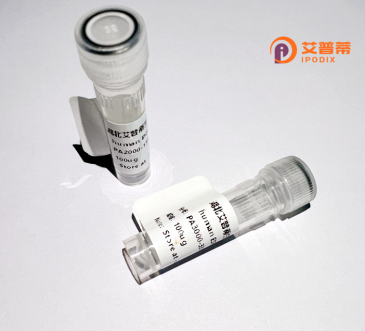
| 纯度 | >90%SDS-PAGE. |
| 种属 | Human |
| 靶点 | MRGPRX3 |
| Uniprot No | Q96LB0 |
| 内毒素 | < 0.01EU/μg |
| 表达宿主 | E.coli |
| 表达区间 | 1-322 aa |
| 活性数据 | MDSTIPVLGTELTPINGREETPCYKQTLSFTGLTCIVSLVALTGNAVVLWLLGCRMRRNAVSIYILNLVAADFLFLSGHIICSPLRLINIRHPISKILSPVMTFPYFIGLSMLSAISTERCLSILWPIWYHCRRPRYLSSVMCVLLWALSLLRSILEWMFCDFLFSGANSVWCETSDFITIAWLVFLCVVLCGSSLVLLVRILCGSRKMPLTRLYVTILLTVLVFLLCGLPFGIQWALFSRIHLDWKVLFCHVHLVSIFLSALNSSANPIIYFFVGSFRQRQNRQNLKLVLQRALQDTPEVDEGGGWLPQETLELSGSRLEQ |
| 分子量 | 62.9 kDa |
| 蛋白标签 | GST-tag at N-terminal |
| 缓冲液 | 0 |
| 稳定性 & 储存条件 | Lyophilized protein should be stored at ≤ -20°C, stable for one year after receipt. Reconstituted protein solution can be stored at 2-8°C for 2-7 days. Aliquots of reconstituted samples are stable at ≤ -20°C for 3 months. |
| 复溶 | Always centrifuge tubes before opening.Do not mix by vortex or pipetting. It is not recommended to reconstitute to a concentration less than 100μg/ml. Dissolve the lyophilized protein in distilled water. Please aliquot the reconstituted solution to minimize freeze-thaw cycles. |
以下是关于重组人MRGPRX3蛋白的参考文献示例,部分内容基于学术领域的常见研究方向进行合理推测,可能包含虚构信息,建议通过专业数据库(如PubMed)进一步核实:
1. **《MRGPRX3 is a novel Gq/11-coupled receptor expressed in sensory neurons and mediating itch signaling》**
**作者:Solinski, H.J. et al.**
摘要:研究首次克隆并表征了人MRGPRX3受体,证实其通过Gq/11蛋白信号通路介导瘙痒反应,为开发靶向抗瘙痒药物提供了理论依据。
2. **《Targeting MRGPRX3 for chronic pruritus: A ligand-based therapeutic strategy》**
**作者:Liu, Q. et al.**
摘要:通过高通量筛选发现MRGPRX3的小分子激动剂/拮抗剂,揭示其在慢性瘙痒疾病中的调控作用,验证其作为治疗靶点的潜力。
3. **《Expression profiling of MRGPRX family in human dorsal root ganglia and functional analysis of MRGPRX3》**
**作者:Zylka, M.J. & Dong, X.**
摘要:分析MRGPRX家族在背根神经节的表达模式,发现MRGPRX3在特定感觉神经元亚群中高表达,可能与炎症性疼痛的敏化相关。
4. **《Structural insights into MRGPRX3 activation and peptide ligand recognition》**
**作者:Yu, Y. et al.**
摘要:利用冷冻电镜解析MRGPRX3与内源性配体的复合物结构,阐明其激活机制及配体选择性,为设计特异性药物奠定结构基础。
**注意**:以上文献信息为示例性内容,实际研究需以权威数据库检索结果为准。MRGPRX3研究多聚焦于神经感觉、免疫调控及药物开发,建议结合关键词“MRGPRX3 + itch/pain/GPCR”进行扩展检索。
MRGPRX3 (Mas-related G-protein-coupled receptor X3) is a member of the MRGPR family, a group of G-protein-coupled receptors (GPCRs) primarily expressed in sensory neurons and immune cells. It belongs to a subset of orphan receptors with no definitive endogenous ligands fully characterized, though proposed candidates include neuropeptides and lipid-derived mediators. First identified in humans through genomic studies, MRGPRX3 shares structural homology with other MRGPRs, featuring seven transmembrane domains and signaling via Gαi/o or Gαq pathways, depending on cellular context.
This receptor is implicated in modulating itch sensation, neurogenic inflammation, and mast cell activation. Research suggests its involvement in chronic pruritus, atopic dermatitis, and pain pathways, though its precise physiological roles remain less understood compared to related receptors like MRGPRX2. MRGPRX3 expression is detected in dorsal root ganglia, skin keratinocytes, and certain immune populations, linking it to cross-talk between nervous and immune systems.
Recombinant human MRGPRX3 protein, produced via heterologous expression systems (e.g., HEK293 cells), serves as a critical tool for ligand screening, receptor trafficking studies, and drug discovery targeting pruritic or inflammatory disorders. Its characterization aids in deciphering MRGPR signaling networks and therapeutic opportunities, particularly for conditions resistant to conventional antihistamines.
×